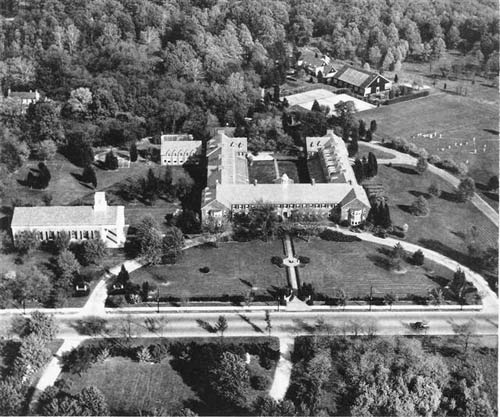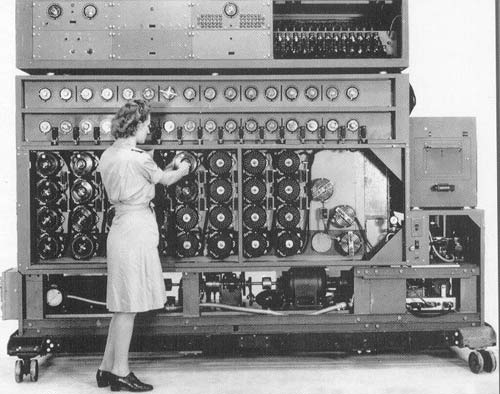
(The Mount Vernon Seminary for Girls in the late 1930s before it became the Naval Security Station. Image from Bill Lockert, CTTCM, USN, Ret.).
Man, that was a hell of storm that swept across the region yesterday. It was what was left of Tropical Depression Bill, the second named storm of the year that came off the Gulf and swept to the northeast.
I was sitting out on the patio, watching the sheets of rain in the gathering dusk, punctuated by flashes of lighting- one of which hit the building and almost caused me to leap out of my Adirondack chair.
I couldn’t get back to what I was doing, which was to do some research on the Nebraska Avenue Complex (NAC), a facility I intend to use as a prop for a talk to the Australians this afternoon. I prefer having a cocktail and watching the majesty and power of Mother Nature in action.
I had some interaction with the facility over the years. In Mac Shower’s WWII day, it had been Station NEGAT, the Washington DC hub of Naval cryptology, the art of breaking Japanese Naval codes. It had been Mount Vernon Seminary, a non-sectarian private girl’s school founded in 1917 to educate the daughters of Washington’s diplomatic Corps, and appropriated by the Navy in 1942 to support the war effort “for the duration.”
That duration lasted right through the Cold War, to 1995 when the Cryppie commands were consolidated at NSA in Fort Meade, and the NAC subsequently appeared to be slipping into the sleepy hallow of the post-war defense reductions. That changed abruptly changed with the terror attacks on 9/11.
The first acts of the Office of Homeland Security, then in the White House, was to set up a watch floor at the complex, and with the establishment of the Department of Homeland Security, DHS moved in with all its size 12 DDD shoes and became a cabinet-level institution. I worked there for a while, establishing a watch position to conduct liaison with State, local and tribal governments.
It was a tight fit on the campus.
The only place to eat on the Station was a Subway sandwich shop, and the bright lights of Tenleytown were a brisk twenty- minute walk away up the Avenue. Jarrod Fogel lost 245 pounds eating at Subway- and I understand why.
They are building the glittering DHS new Headquarters across I-295 on the grounds of St. Elizabeth’s Hospital for the Insane and will be committing themselves there shortly. I don’t know what will happen to the NAC, but the real estate is too valuable to lie fallow for long.
In early 1943, for example, over 1,100 men and women were working at the Station on the complex problems associated with code-breaking. By the end of WWII, there were over 5,000 persons on the job, serving the early mechanical computing engines called “bombes.”
It is worth a digression to talk about the first Computers. The Brits had fielded their first, manufactured by the British Tabulating Machine concern, based on the Polish exploitation of the early German Enigma code machines, in 1940 at the famed Bletchley Park campus.
The Germans continually updated their Enigmas, introducing a four-rotor model to add to the early production models that had only three. In addition, they changed all their code-books resulting in a blackout at Bletchley that lasted from February to October of 1942.

That was the darkest part of the U-boat war, and resources were tight in Britain. Long reluctant to share with the Cousins on the other side of the Atlantic, the imperative of the time led to a visit to the National Cash Register Company in Dayton, OH, by the legendary Alan Turing. The US-Bombe was built by the National Cash Registers (NCR) in Dayton Initially the Navy stated a requirement for a fully electronic machine, but designer Joe Desch estimated that it would need over 70,000 vacuum tubes to run.
Toward the end of 1942, Desch proposed a less sophisticated design similar to that of the Brits, but faster and more reliable. The Navy jumped on the proposal and the first prototypes were operational in mid-1943. After working out some initial bugs, the NCR-built bombe proved to be “reliable, fast and effective.” By the end of 1943, 120 machines were operational, most at Nebraska Avenue attacking the German U-Boat message traffic. For the remainder of the war, the USN took the lead on breaking the codes, sharing the highly sensitive decryptions with the US 10th Fleet sub-hunters and the Royal Navy.
After the war, all US Bombe were destroyed, except for one unit that is now on display at the National Cryptologic Museum at Fort Meade.
But of course there is much more to the story than machines. Part of the total war effort was the integration of women into the Navy. Many were accepted into uniform as “Women Accepted for Emergency Volunteer Service,” or WAVES.
My parents met on a blind date set up by a couple with whom they remained close friends the rest of their lives. Three of them are gone now, but the last time we were together was a dinner I hosted at Bobby Van’s Grill on New York Avenue in 2008. As it turned out, Babs (not her real name) had worked in Washington during the War, and had been a WAVE Lieutenant. Having been in the Navy and a Spook myself, I was fascinated and asked her some questions:
“Where did you work?”
“Oh, a place by Ward Circle.”
“Not Nebraska Avenue?”
“Well, yes.”
“Did you work on the bombes?”
Her face went white and she refused to speak further. I felt bad about making her uncomfortable, and told her to relax. All that material had been declassified years before. “Heck, I can even take you up to Fort Meade and show you the only remaining one.”
She shook her head emphatically. “No. They told us that if we ever spoke about what we did, they would come after us and throw us in jail for the rest of our lives. I am not taking any chances at this late date.”
We changed the subject to how single women got by in a town that was bulging at the seams from the influx of war workers. That is the way it is in Washington. If you are not sure they are going to come after you, it is better to change the subject or just keep your mouth shut. That is part of the story about what happened literally across the street- 4100 Nebraska Avenue- from the main entrance to the NAC.
It was a house rented by a guy named Kim Philby. But we will have to get to that tomorrow. I have a tour to give.
Copyright 2015 Vic Socotra
www.vicsocotra.com
Twitter: @jayare303
